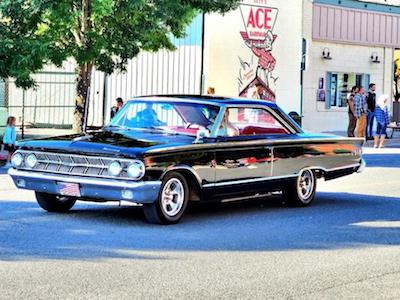By Greg Zyla —
I’m going to explain my love of Mercury automobiles the best I can, because it began when I was in kindergarten at Saint Anthony’s school in Ranshaw, Pa., back in 1954. I remember at school’s end of year we had a student program and the esteemed head of our church, Monsignor Thomas Bartol, attended as the main guest.
I was selected to go in front of the assembly to welcome the Monsignor, and all I had to say was this, “Monsignor, welcome to our show, and if we knew you were coming we would have baked a cake.”
The Monsignor stood up, everyone clapped, and he gave me a hug. From that day Monsignor Bartol was my friend, and not long after our school program he bought a brand new 1955 Mercury Montclair in two-tone orange and white.
As explained in past columns, the best part of my day at age five was standing on our porch two stories up at 247 Main St. and watching the cars go by. When Monsignor would pass by he always waved to me and beeped his Mercury’s horn several times.
The Monsignor saying hello via that beautiful Mercury was high on my list of happiness moments. It lasted until my father landed a new job in south Jersey and the family moved in 1958. Monsignor passed away in 1969.
Next playing the role was my uncle, John Goretski, who worked at Edison, N.J. Ford, and Mercury assembly line, not far from Menlo Park. When we would visit, he and my aunt Rose at Rutgers Village near New Brunswick, N.J, he would always take us, including their daughter JoAnne, to the Menlo and Edison Parks. To get there, Uncle John always drove past the Mercury division where I saw hundreds of brand new Mercury’s sitting and awaiting delivery. None had hubcaps on, and my uncle explained they were safely packed away in the trunk and the dealers would put them on when they received their cars.
Fast forward, and it’s 1966. This is the year that Mercury receives credit for the first ever flip top funny cars, of which four were constructed. My memory remembers Dyno Don Nicholson, Eddie Shwartman, Kenz and Leslie, and Jack Christman as the lucky drivers.
All had a special Logghe Chassis underneath, which back then was the leading chassis constructor. I saw them run in person at Atco Dragway in 1966, and I was literally blown away by the performance of these all-new Funny Car Mercurys.
My last memorable memory was a street race for $100 between me and my ’68 Camaro 396/375 against a 1969 Mercury Cougar Super Cobra Jet 428 owned by a fellow student at Mt. St. Mary’s college, where I graduated from in 1973. Unbeknownst to me, the kid who owned the fabulous Cougar was the son of the dad who owned the NFL’s Baltimore Colts football team, which I learned years later from one of the attendees at the race. His name is Larry O’Donohue, who made a name for himself, thanks to his syndicated radio show where I have been a guest many times. Called “In the Pits,” Larry is taking a breather and doing a reformat of the show that will debut in 2025.
Anyway, the kids’ Cobra Jet Cougar fell prey to a driver with little experience, as Larry told me he just sat there burning the rear tires away while I was long gone and the $100 was heading into my pocket. I hate to even bring this up as it was 100% illegal, but shooting pool and racing my car is how I made my spending money while at the Mount.

This 1964 Mercury Marauder is owned by John May, from Spokane, Washington. It is powered by a 427, with two four-barrel carbs. (May Photo)
In ending this portion of this week’s Mercury memories, here is a list of extremely fast Mercurys that Ford built along the way. 1964 Comet Factory Experimental was Mercury’s first official foray into drag racing and they wooed away Dyno Don’ Nicholson to join the factory backed team. Big 427 under the hood, it was mighty fast.
Next is the 1967 Comet R-Code 220 post sedan with a 427 side-oiler with two four barrels under the hood. Only 22 took advantage of this option and Mecum auction sold one for close to $200,000 in 2014. The 1968 Cougar XR-7 G (for Gurney) is next with the 428 Cobra Jet under the hood; 1970 Cougar Boss 302 rates a call, as does the 1970 Cyclone Spoiler 429 Super Cobra Jet. Next is a 1964 Mercury Super Marauder 427 R-Code, just like my friend John May in Spokane, Washington owns. These Marauders were terrors on the NASCAR circuit. Does anyone remember the 1968 Cougar XR-7 GTE 427and then replaced mid-year with a ram air 428 Cobra Jet engine? How about a 1970 Cyclone Spoiler Prototype? NASCAR banned it before it reached the track and built it to compete against the winged Dodge Daytona and Plymouth Superbirds. It was also known as the King Cobra in Ford window dressing.
Finally, I’ve got to mention the 2003 Mercury Marauder which I test drove for a week and came away impressed. Similar in theory to the rear drive ’94 to ’96 Impala SS with the LT-1 under the hood, I give Mercury a pat on the back for building the modern-era Marauder with a Cobra style 4.6-liter V8 under the hood. I gave this Mercury a major hammering at Pocono during a Mercury Day arranged by Ford, and even though the 4.6 equals about 281 cubic inches, the car was fast. It was only available through 2004. If you are looking to buy one, the 2004 is much better.
Now, let’s end on the collector car hobby here in 2024.
The media plays a big part in not only sustaining the hobby, but also attracting new enthusiasts. From television shows that run regularly to the hundreds of magazines that zero in on the hobby. If you’re a fan of collector cars and trucks you have lots of outlets to take care of your desires. Notables are the television auctions, half-hour and hour-long collector car programs, and the major print publications.
As for the vehicles the enthusiasts buy, everything from a lowly Studebaker Lark to a rare L88 Corvette attract attention at the car shows. Whether you have $3,000 to invest or $30,000, there’s a car out there for just about anyone who wants to enjoy the fun of owning a car and attending the shows.
These collector car shows deserve extra mention, as they come in several flavors. The major car shows, like the ones they hold at Carlisle, Pennsylvania, every year, are wonderful exhibitions of thousands of cars and trucks. However, and just as important as the big shows, the smaller hometown car shows are sometimes just as much fun as the “biggies,” and usually are connected in some way to a local non-profit group, like an area fire company or Rotary Club. As for “cruise-in” events, many are held weekly throughout the warmer months and offer an excellent avenue for involvement.
Perhaps the best indicator of the popularity and strength of the hobby comes in a two-fold example.
First, the number of companies out there catering to the collector car hobby is countless and growing. Everything from tires, interiors, paint, wheels, body parts, complete bodies, engines, flathead parts and more are readily available to one and all.
Second is the strength of the car collector hobby when it comes to politics. Thanks to organizations like the Specialty Equipment Market Association (SEMA), the rights of collector car owners are properly defended when it comes to political correctness.
Thanks to the strength of its government affairs efforts and the proper use of lobbying and working with congress, you can rest assured that the quickest way for a modern-day politician to lose his or her run for office is to produce a bill that limits the rights of a collector car owner. Thanks to SEMA, things like emission compliance for the older cars is just one area of the hobby they involve themselves in. (See SEMA.org for more and to join.)
I personally own several collector cars, none of which are big money vehicles. Included are a 1994 Trans-Am, 1998 Z-28 Camaro, 1972 Challenger 440, and a 1980 AMC Concord. All of these cars have a personal meaning, and I like to work on them regularly as best I can. I again point to the fact that you don’t have to spend an arm and a leg to get into this hobby as the AMC Concord, with just 27,000 original miles, has about $3,000 invested total and purchased on eBay.
And speaking of eBay, let’s end with a bit on social media and its impact on the hobby. Every car collector knows they can go to eBay or YouTube and pretty much entertain themselves for as many hours as they want.
Here’s hoping that more and more people join the collector car hobby.
(Greg Zyla is a syndicated auto columnist who welcomes reader interaction on everything about cars. Contact him at greg@gregzyla.com).




Be the first to comment on "Collector Car; My love of Mercurys and the car hobby growth"